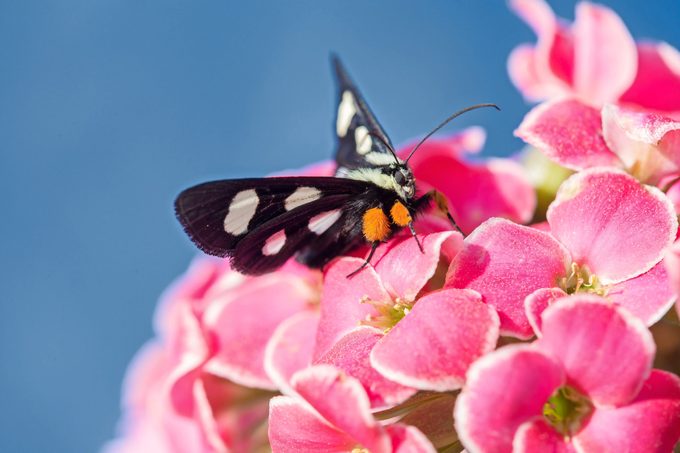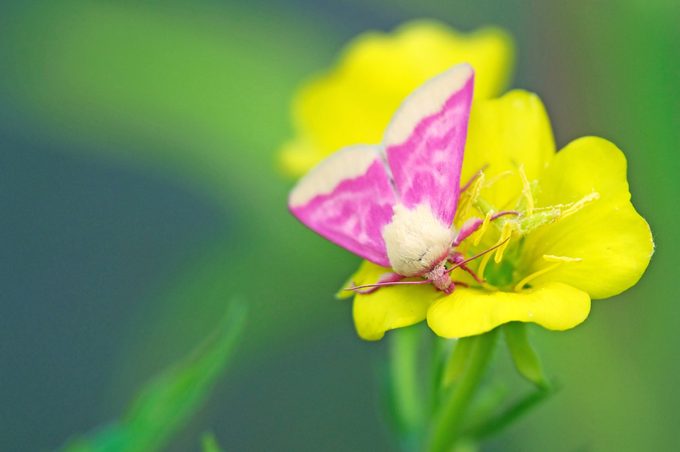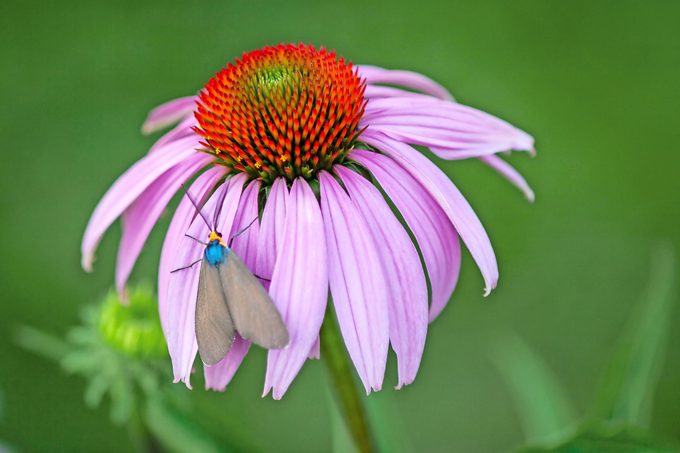Meet the Colorful Moths You Can See During Daytime
Updated: Oct. 22, 2020
Learn more about the bright, colorful moths you can see in your backyard any time of day.
In a popularity contest between butterflies and moths, butterflies would probably win every time. They are beautiful, colorful pollinators that flit around flowers in the sunshine. On the other hand, moths have a reputation as dingy, dull fliers that lurk in the dark.
Maybe moths just need better publicity. They have a lot going for them, including a tremendous amount of variety. In the United States and Canada, there are about 650 butterfly species. For moths, that number is about 11,000. Among that very diverse multitude, some moths wear every color of the rainbow. And although most kinds fly at night, several hundred species are active in the sunlight. Daytime moths are sure to be found nearby wherever you live.

Black-and-White Moths
Many active day-flying moths wear bold patterns of black and white. One of the most familiar is the eight-spotted forester. Its black wings each have two big white to yellowish white spots (for a total of eight), and the bases of its legs are covered with a puff of fuzzy orange scales, giving a fine accent of color.
These moths are often seen fluttering around flowering shrubs and garden blooms in spring and summer. Their larvae—also sporting black, white and orange—feed on Virginia creeper and wild grape leaves. Eight-spotted foresters are common in most states east of the Rockies and are replaced by several kinds of related, similar-looking moths in the West and parts of Canada.
The grapevine epimenis, another small spring moth, shares a variation of that pattern. It has a white spot on each black forewing, but the spot on each hindwing is red. And one of the most spectacular moths may be the faithful beauty moth of South Florida; its black wings are decorated with numerous white spots, a wash of blue and a patch of bright red. Learn 5 interesting facts about hummingbird moths.

Flower Moths
The flower moths (members of the genus Schinia) make up a wonderfully varied and colorful group of more than 120 species. All are quite small, averaging only about half an inch long, and are easy to overlook because they often sit very still on flowers. Some of the more common types include the primrose moth, clouded crimson, ragweed flower moth and arcigera flower moth.
With so many species in this group, they are found practically anywhere in North America. The ornate bella moth is unrelated to flower moths but is equally beautiful. Its forewings are pale pink with rows of tiny black dots; when it flies, its hindwings flash a bright reddish pink. This moth is commonly found in open fields, fluttering low over the grass on sunny days. Follow this helpful cheat sheet to identify butterflies.

Wasp Mimics
While some moths might be passed off as butterflies, others may not be noticed because they look like wasps or other insects. One example is Virginia ctenucha, common in the northern and central states and southern Canada. With a slender metallic blue body, narrow dark wings and an orange head, it can be easily mistaken for a wasp as it actively crawls around flowers.
Other ctenucha moths and a related species called the yellow-collared scape moth also look like wasps at first glance. Some of the southern and subtropical moths are even more impressive mimics. The polka-dot wasp moth looks like a black-and-white wasp with a red tail tip and lives in Florida and the Southeast. The Texas wasp moth (which sometimes wanders far north of Texas) has yellow and black bands like a hornet. It may fool even a careful observer. Although it’s completely harmless, predators tend to leave it alone because it looks as if it could sting.
Here’s the best news about these little marvels: If you have a flower garden, some of these moths are probably visiting your blooms already. But here are some tips to throw a moth party. To attract even more of these beautiful pollinators, grow a variety of flowering plants that bloom throughout the warmer months and avoid using pesticides around your garden. Then keep a close eye on the flowers during the day. There’s a good chance that you’ll spot some of these gems of the moth world.




















